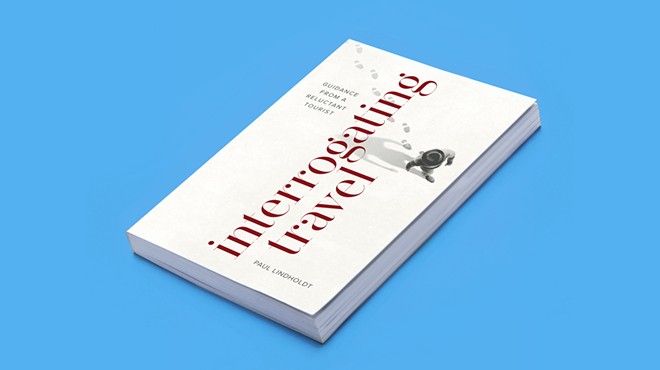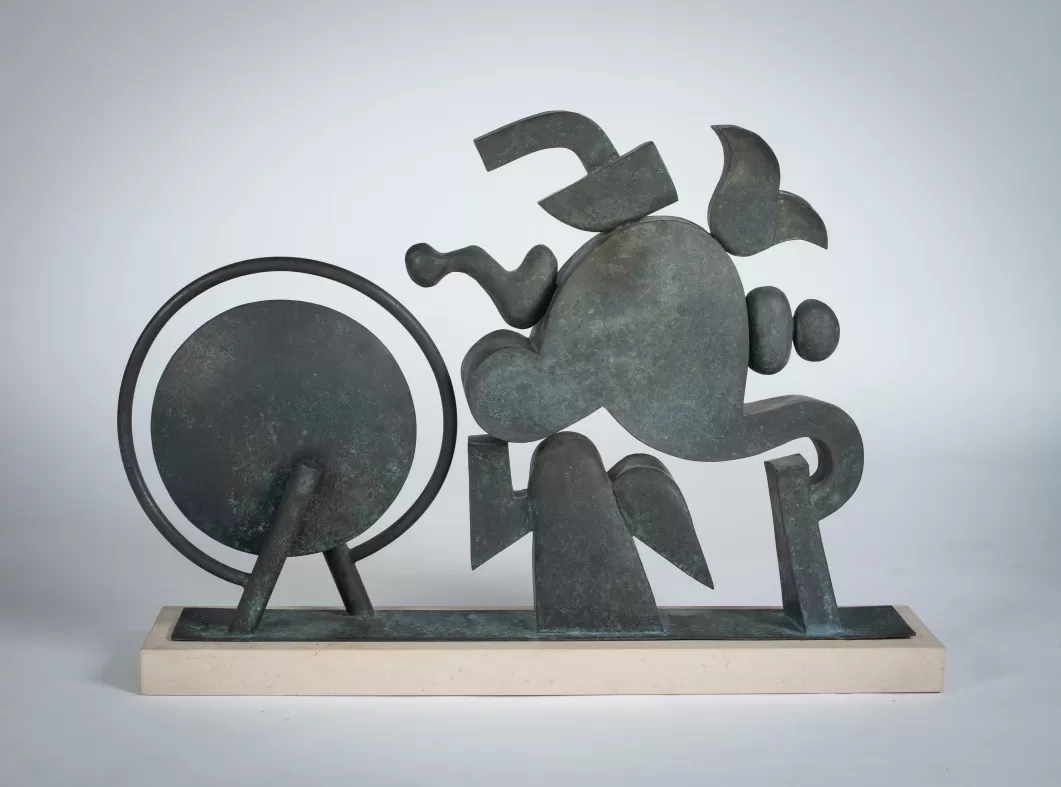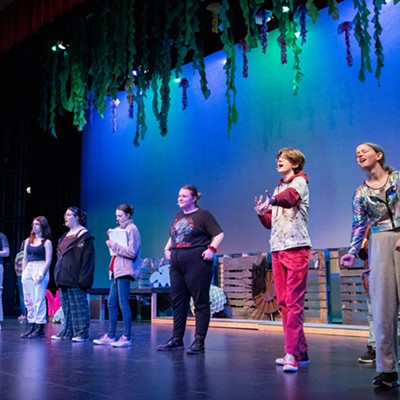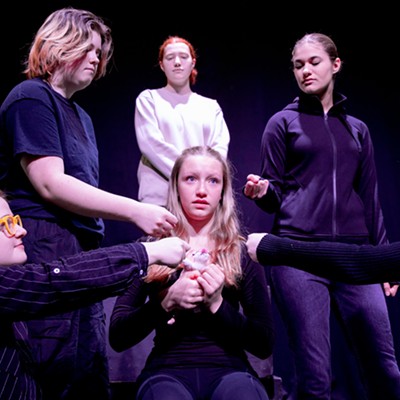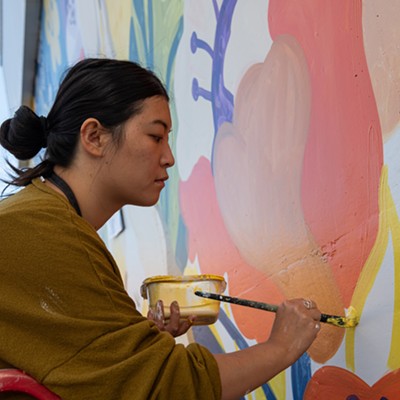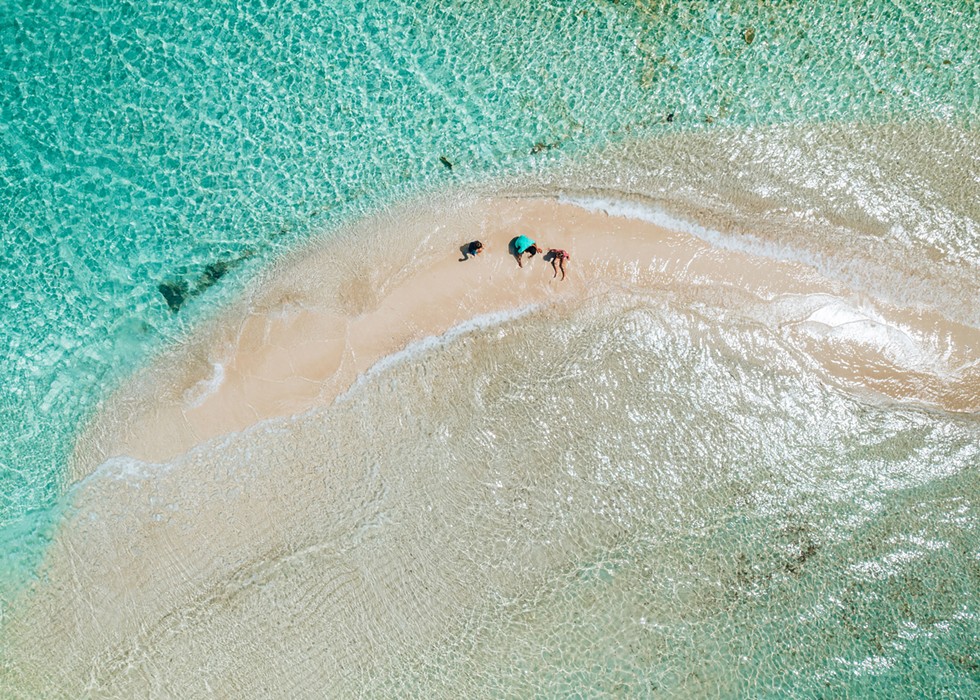
Traveling with my family in Belize, I first heard the assertion that "sustainable travel is an oxymoron." Tourist-wrangler Judy duPlooy said it.
With my spouse, Karen, and our two sons, Chase and Reed, I was visiting Judy's jungle lodge for some R&R and ecotours. The four of us shared two cabinas and kept eyes open wide for the ginormous spiders that are said to creep the tropics.
Judy's U.S. clients begin their trip at a stateside airline hub and then jet down to Belize City. There they clamber aboard a bumpy puddle-jumper, wing it to San Ignacio, pile into a 10-person shuttle van, and twine past tiny Santa Elena to arrive at Sweet Songs Jungle Lodge.
"How did you come into the hospitality biz?" I asked my new friend Judy. Already I had confided to her how our resource-intensive voyage from Seattle had set my teeth on edge.
Judy arrived from South Carolina some 30 years before we met. With her husband, Ken, and their five daughters, they bought the riverside farm and transformed it into an ecotour destination. When Ken died from heart disease, Judy raised their daughters by herself.
In her resort of 48 employees, sun supplies the power for a large arboretum and another 160 acres of cabins and jungle. Guanacaste trees shade the grounds — towering, flowering deciduous giants whose limbs spread low and wide.
In an observation dome above the Macal River, day-blind bats swathed the rafters like mistletoe. Agoutis, known by the locals as bush rabbits, proved so adaptable to human presence that they resembled statuary on the grounds.
During breakfast our first full day aboard, Judy's staff served hibiscus juice, the first time we had tasted it. Outside the window of the dining hall, a flock of toucans were likewise dining, swiveling upside down and plucking fruit from a palm tree.
Judy joined us at the table. She leaned in and murmured to me so no one else could hear, "Sustainable travel is an oxymoron."
AMONG THE TOURISTS
Dyed-in-the-wool enviros, Karen and I travel abroad and take our kids along. We want them to get out and see the world. Too often, though, the imp of liberal guilt seizes me.
To spew so much carbon has always nagged. It grinds me to support chichi resorts and short-let rentals that blight the shorelines of so many nations. It badgers me to see our first-world tourist dollars quash indigenous lifeways and overturn economies.
One evening during our visit to Judy's resort, a Maya guide named Mario took us on a sweltering nocturnal tour. He led us along jungle paths to try to spy night-thriving kinkajous. None showed. In the distance, though, we could hear strange grinding booms.
"What is that, Mario?" Karen pointed toward the sounds.
"Those are cane toads. Their familia traveled to our country and they stayed."
Later I Googled the species and learned they are in fact native to the nation. Mario seemed to have confused those voluble amphibians with the settler-colonists, the retirees especially, that are growing so abundant in his country.
Cane toads can swallow other species whole by ratcheting their wide mouths wider. They dart long tongues to capture prey. Coordinated forelegs cram in writhing insects, birds, other amphibians, even small mammals. Their croaks like hand-rasps punctuate the night.
Cane toads also harbor cocktails of neurotoxins beneath their skin. Those cocktails contain DMT, a psychoactive some people ingest for therapy or fun. Foreign trippers dry and smoke it.
If it sounds too fantastic to be true, that is the Caribbean for you. The blue-beyond-belief seascapes shed tensions. Ruins the Maya people left behind prove too trippy to refuse. Cane toads have what it takes to gratify outsized postcolonial appetites that wing in on the jet stream every day.
Like Philip Larkin's speaker in his poem "Church Going," we tourists blink aside certain tropical sensations and consider others a delight. The poet dubbed our species "ruin-bibbers." People who are thirsty to imbibe the ruins of the past.
As much as we relished Judy's jungle lodge, we were keen to see the Caribbean Sea. Soon we found ourselves on the water at Ambergris Caye.
Snub-nosed and scale-plated iguanas were creeping everywhere we went. Survivors like the ancient Maya of the region, those lizards resemble armored vehicles.
Iguanas wedge tight in Earth-cracks and baffle efforts to extract them. That gift became plain when a pair of boys and their dog chased one deep into a rockpile.
The boys dislodged the basalt. The dog beside them yapped and dug. The iguana crept further within the rocky recesses.
I approached the boys. "Why do you chase him?"
"We like to eat wish-willy!" one of them sang out.
Their smirks said they were messing with me, goading the gullible gringo. Still, people in Belize do eat iguanas. They dub them gallina de palo, meaning chicken of the trees.
A much larger iguana, spiky like a dragon, materialized for us the next day. We tiptoed so as not to scare it. From behind a pine its surprise handler rose, his lizard leashed as if it were a dog.
What were the two of them doing on that white-sand beach? The handler with his banded straw hat and aviator glasses, the lizard fastened by a harness so it could not wriggle free?
Just then a tourist in Bermuda shorts approached and leaned to snap a pic. The handler moved between the two, his palm outstretched, his prickly living prisoner his vehicle to navigate the gig economy. The tourist reached inside a vertical slot of pocket and paid up.
Using insights from Seattle-based travel writer Rick Steves, only about 11 percent of the planetary population has the motivation and the means to travel internationally. Count us among the privileged 11-percenters.
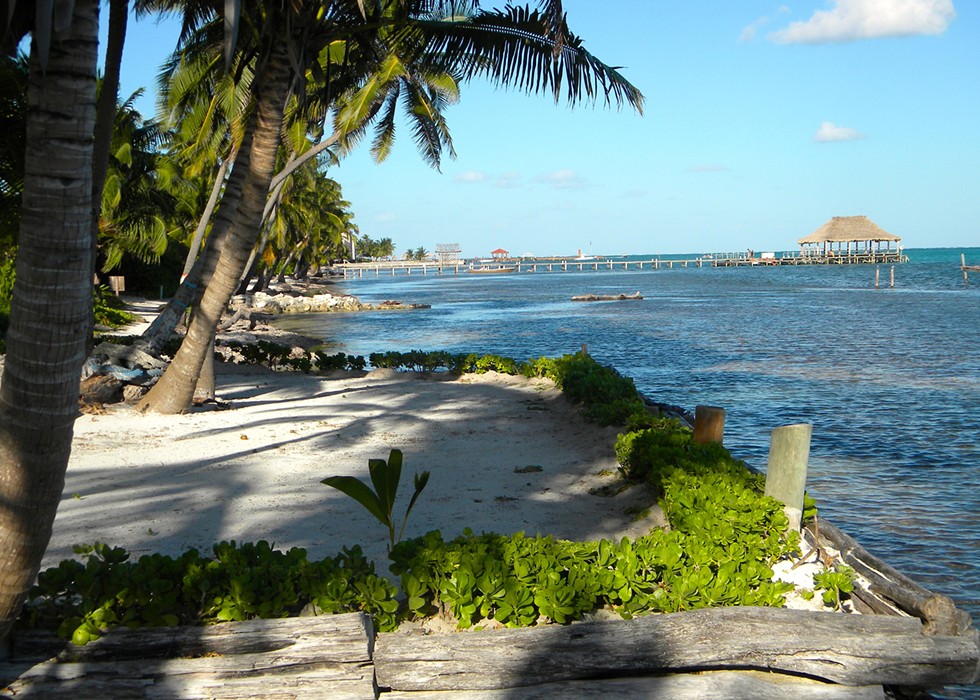
UNNATURAL SELECTION
Our next excursion took us to Barton Creek Cave, billed as a thrilling underground tour into the past. We rented canoes. The boys shared one paddle craft, their mother and I another.
The cave opened to a lengthy river within, a "single-passage resurging stream cave," our guidebook called it. Prehistoric people favored it for their religious rituals.
From the cave a cold breeze blew, as if the ancients were warning us away. Our guide Noel hinted that the Maya remain a potent presence, their energies contracted in that watery spot.
We huddled in our canoes at the cave mouth and whispered. Water dripped. Stalagmites and stalactites, some still growing, some long dormant, rose and fell like grinding teeth.
Noel's mestizo mix is Maya and French. Formerly a cab driver, he speaks skillful English. He profiled the ancients as barbaric and ritualized. The beam of his laser pointer, a proxy for his voice, guided our gaze.
The gods demanded sacrifices, Noel said, and human blood appeased the rain god, Chaac. The dripping of blood, as I deciphered it, mimicked the rain that the people needed to survive.
The Maya enjoyed a good run, in my mind, but homage to a pantheon of savage gods brought about the murder of their women and their slaves. The fittest and most nubile among them were singled out to die. In a kind of unnatural selection, too few baby-bearers remained.
Other causes of the Maya decimation are subject to conjecture. A scarcity of food and water might have starved them out. A rise in cyclones might have weakened them further. Mercury and blue-green algae toxified some aquifers and drove them from their towns.
Travelers are the primary agents of epidemiological exchange. Like Columbus, who brought contagion to the isolated and susceptible Americas, we travelers transmit viruses. It's not if but when the next killer of a virus will descend and take its toll, most scientists agree.
In the 2021 film Roadrunner, Anthony Bourdain poses before a hand-printed sign advising viewers "Be a traveler not a tourist." His distinction is hazy, his operative borders porous.
SURVIVAL IS AN ART
Our next excursion had us ecotouring under the direction of a different Maya guide.
Abel Coe was erudite in all Belizean ecology. His mustache gave him a serious air, but he was playful enough that he could feign an attack on Chase's fingers with a captured crab. Chase set aside his handheld game console and elbowed to be first in line.
Abel used to bust his knuckles on a monkey wrench. As a leader of ecotours now, he seems to have found his calling. He is a rare instance of the tourist industry improving a native's quality of life. The benefits he enjoys are unsustainable, though, as shown by the downturns suffered during the devastating pandemic by tourist-reliant peoples such as him.
Abel beached his boat at a breeding islet for American crocodiles. They reproduce in a brackish pond screened by trees. Drag marks from tails appeared once we stepped ashore. Every trope about marooning on a desert island came alive — from Robinson Crusoe to Willie Gilligan to the Tom Hanks character in Cast Away.
Red mangrove trees, taking root upon and buffering the beach ridges, stabilize the islet. Aerating roots called pneumatophores rise above the water to help the trees to breathe. Leaves, carcasses, flotsam, and shells elevate and enrich the shoreline forest.
"If survival is an art," my writing mentor Annie Dillard noted, "then mangroves are artists of the beautiful: not only that they exist at all — smooth-barked, glossy-leaved, thickets of lapped mystery — but that they can and do exist as floating islands, as trees upright and loose, alive and homeless on the water."
In mangrove branches above our slough, boat-billed herons nested. Crocodiles scarf fledglings that tumble from the nests. Adult herons feed on fresh-hatched crocodiles in their turn.
It's all ecology in motion, like the ouroboros, that mythical snake believed to tumble hooplike with its own tail in its jaws. That snake's spherical enclosure, changing always while it keeps its shape, makes it a fit emblem for enduring hurricanes and civilization's brutal sieges.
Crocodiles, underwater charismata 4 to 8 feet long, slunk from shore for my family and me. An old croc nest beneath our feet displayed crinkly epidermal shell debris.
Next, we followed Abel underwater to snorkel a Technicolor reef. Modeling good ecological behavior, he placed a single finger on underwater rocks and coral ledges and held himself stock-steady there. That single finger safeguarded vulnerable microorganisms.
Abel probed dark crevices to prompt marine creatures to reveal. He pointed out an eel, a nurse shark, a spiny lobster.
Finning up behind a yellow ray lying all but buried in the sand, he gave its tail an impish tug. The animal fled 10 feet before calling a halt at a silty spot, scooting fore and aft like a brood hen settling on a nest, then camouflaging itself to still-hunt once again.
In Abel's wake we finned along for a mile. Eagle rays, electric rays, rough-tailed rays, yellow rays, and manta rays drifted by like lazy lapwings on their tranquil way nowhere. Those cartilaginous fish, flapping overhead, caused us reflexively to duck.
Abel thrilled the boys by putting a constellation of starfish in their hands. Squiggly bristle stars, puffy cushion stars, spooky serpent stars. After each encounter, each abduction undertaken to enlarge their environmental education, he put the creepy-crawly back in its exact same spot.
Those stars made me wonder if the pagan gods approved, if they found our travel in Belize to be sustainable enough to satisfy.
tweet this
A SECOND WIND
After our snorkeling excursion, we slumped back to our cabina all done in. We threw together a supper of rice and beans and shrimp ceviche. The boys began to fade. We almost followed them to bed, but a second wind freshened Karen and me.
We shut the door behind us and slid into the sea. Tiny teeming jellyfish shocked us dully, our hip-wakes enhancing their pleasant prickles. Bioluminescent plankton swirled to mirror the stars that seemed to gawk at us from above.
Those stars made me wonder if the pagan gods approved, if they found our travel in Belize to be sustainable enough to satisfy.
Once we got back, the drowsy boys asked us to adjust the mosquito netting above their beds. Daddy duty, I was glad to do it. All of us had been stung and had the welts to show it. Mosquitoes spread Zika, yellow fever, dengue, and malaria.
Standing on a straight-back chair, I closed the gap above Chase's netting, which flowed down from the ceiling like a wedding dress to tuck in at the edges of his bed.
When I stood up to adjust Reed's mosquito net, I found myself eye-to-eye with the biggest spider I had ever seen. A tiger bromeliad, more than four inches wide, appeared to be using the cotton mesh like a web to capture prey.
What to do? If I let Reed in on my secret, he would not sleep. Already, before first light each day, howler monkeys were startling us awake, roaring through the treetops like a pride of lions. I was going to have to capture and haul away the monster spider unseen.
Slipping into the bathroom, I seized a hand towel and climbed back on the chair. Coolly as I could, I clapped my hand over the spider and crimped the towel around it like a baseball glove.
Assuring Reed that all was well, I headed for the door. Forty feet outside the cabina, I snapped the towel and flung the spider from me. That leggy creature hit the ground at full run and headed right back toward our lodging.
"Oh, yes," the property manager told me the next day, "those spiders are territorial. That one considered the cabina to be his and was only tolerating you." ♦
Paul Lindholdt is a professor of English and philosophy at Eastern Washington University, where he teaches literature and environmental humanities. He has published some 200 books, chapters, journal articles, essays, columns, reviews, and poems. His latest book, Interrogating Travel: Guidance from a Reluctant Tourist, was published this month.
The article has been changed to show that about 11 percent of the global population has the means to travel abroad.

